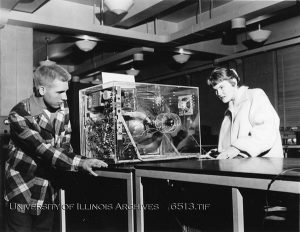
Few innovations have captured the imagination as much as the computer, and even fewer academic archives have had the opportunity to preserve its history. The University Archives houses records that chronicle not only the history of computing at the University of Illinois, but also the “campus’ past, present, and future romance with it.”[1] Indeed, the University Archives contains records documenting Cyberfest ’97, a series of events held March 10-14, 1997, which celebrated the birth of HAL 9000 – the deceptive, clever, and sinister computer in Arthur C. Clarke’s and Stanley Kubrick’s 2001: A Space Odyssey, who “became operational at the HAL Plant in Urbana, Illinois” – as well as the plethora of technologies wrought by the computer.[2]
Continue reading “The Birth of the Computer Age at Illinois”
